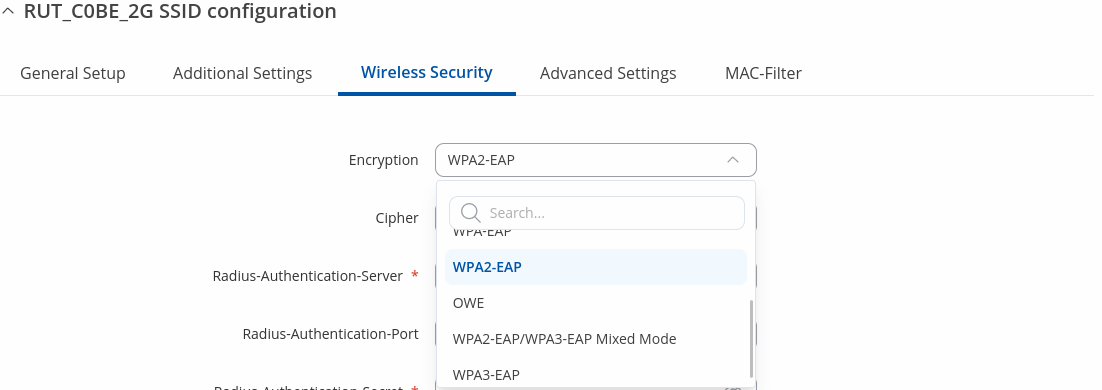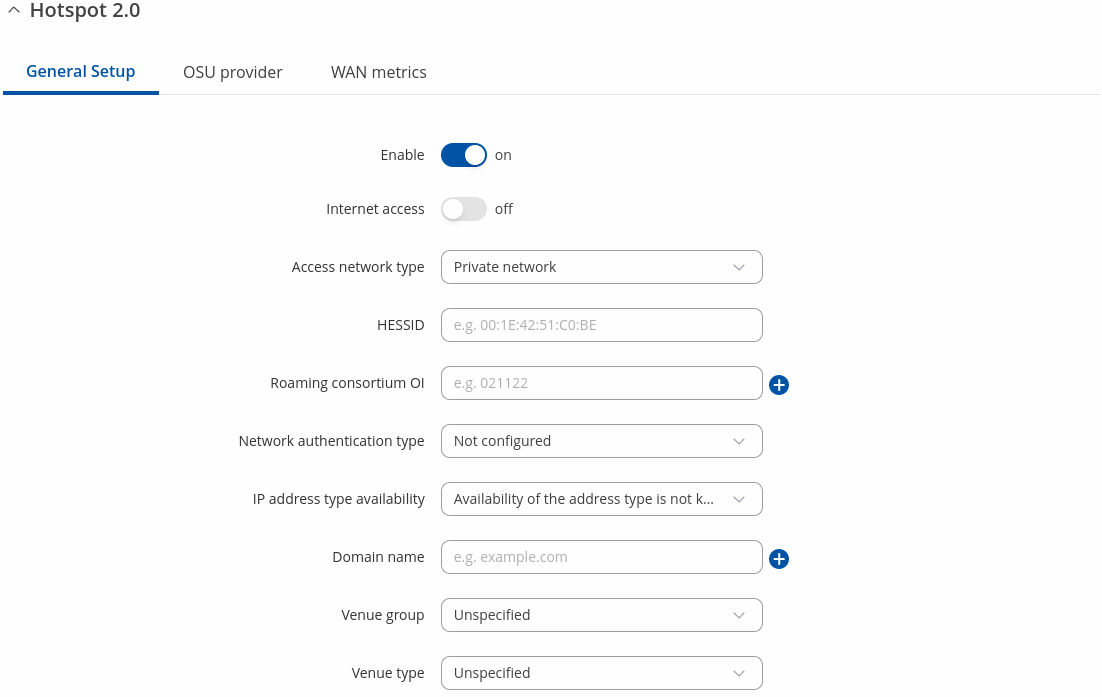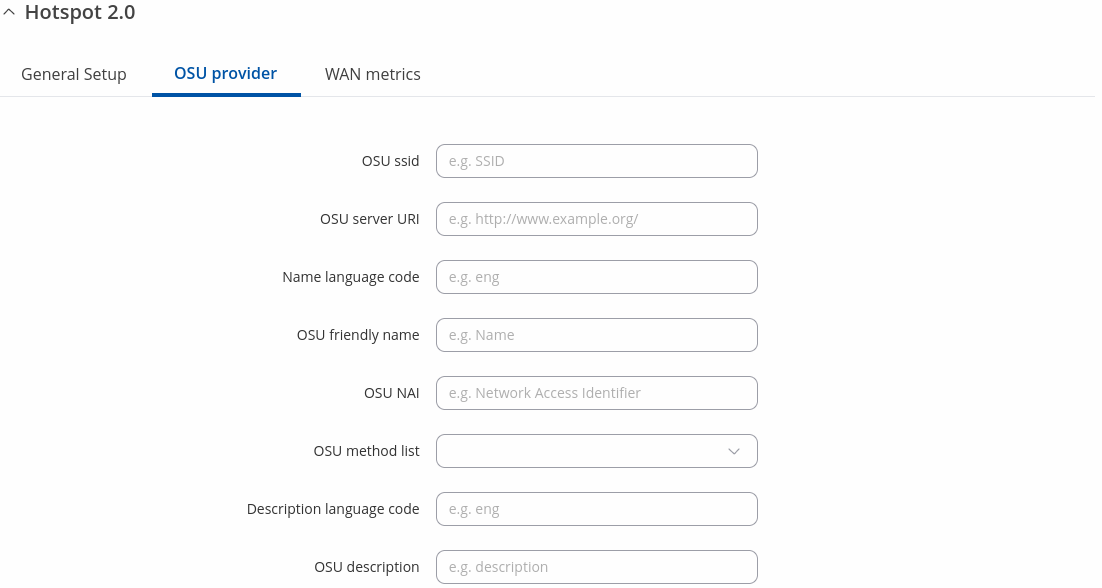TAP100 Hotspot: Difference between revisions
No edit summary |
No edit summary |
||
| (One intermediate revision by one other user not shown) | |||
| Line 1: | Line 1: | ||
{{Template: | {{Template: Networking_tap_manual_hotspot | ||
<!------------------------DEVICE-----------------------> | <!------------------------DEVICE-----------------------> | ||
| name = TAP100 | | name = TAP100 | ||
| series = TAP100 | | series = TAP100 | ||
<!----------------------SEPARATORS---------------------> | <!----------------------SEPARATORS---------------------> | ||
| wifi = | | wifi = 1 | ||
| mobile = 0 | | mobile = 0 | ||
}} | }} | ||
Latest revision as of 14:16, 28 August 2024
Main Page > TAP Access Points > TAP100 > TAP100 Manual > TAP100 WebUI > TAP100 Services section > TAP100 HotspotThe information in this page is updated in accordance with firmware version TAP100_R_00.07.10.2.
Summary
On Teltonika Networks TAP series devices a Hotspot 2.0 is a service that provides authentication, authorization and accounting for a network. This chapter is an overview of the Hotspot section for TAP100 devices.
Hotspot 2.0
The Hotspot 2.0 displays available WiFi interfaces. In order to begin configuring an interface click the 'Edit' button next to it:
After this you should be redirected to the configuration page for that interface.
Hotspot 2.0 Configuration
The main configuration parameters of a Hotspot 2.0 interface will be discussed in this section.
A Hotspot 2.0 interface requires WPA2-EAP encryption. You can configure it in the Network → Wireless page (click 'Edit' next to an interface and find the Wireless Security section).
General Setup
| Field | Value | Description |
|---|---|---|
| Enable | off | on; default: off | Turns Hotspot 2.0 for this interface on or off. |
| Internet access | off | on; default: off | Is used to inform the client device whether internet access is available. |
| Access Network Type | Private network | Private network with guest access | Chargeable public network | Free public network | Personal device network | Emergency services only network | Test or experimental; default: Private network | The access network type present in beacon and probe response frames. Mobile devices can use this information when selecting a hotspot. |
| HESSID | mac; default: none | Homogeneous ESS identifier (optional). This shall be identical to one of the BSSIDs in the homogeneous ESS. |
| Roaming consortium OI | 3 or 5 octet hexstring; default: none | Only first three entries are available through Beacon and Probe Response frames. |
| Network authentication type | Not configured | Acceptance of terms and conditions | On-line enrollment supported | http/https redirection | DNS redirection; default: Not configured | Type of authentication used on this network. |
| Redirect URL | url; default: none | Http/https redirection link. |
| IP Address type availability | Address type not available | Public IPv1 address available | Port restricted IPv4 address available | Single NATed IPv4 address available | Double NATed IPv4 address available | Port restricted IPv4 address and single NATed IPv4 address available | Port restricted IPv4 address and double NATed IPv4 address available | Availability of the address type is not known; default: Availability of the address type is not known | Provides information about the IP address version and type that would be available to a mobile device after it authenticates to the network. |
| Domain name | domain name; default: none | The Domain Name ANQP-element provides a list of one or more domain names of the entity operating the hotspot network. |
| Venue group | various; default: Unspecified | Describes the venue in which the hotspot is located. |
| Venue type | various; default: Unspecified | Describes the venue in which the hotspot is located. |
OSU Provider
| Field | Value | Description |
|---|---|---|
| OSU ssid | string; default: none | Informs client devices about the SSID used for OSU connections. |
| OSU server URL | url; default: none | Is used to inform the client device whether internet access is available. |
| Name language code | string; default: none | Two or three character language code (ISO-639). |
| OSU friendly name | string; default: none | User-friendly name of an OSU service provider. |
| OSU NAI | string; default: none | OSU network access identifier. |
| OSU method list | OMA-DM | SOAP-XML; default: none | Configures the supported OSU method(s) of the OSU provider. |
| Description language code | string; default: none | Two or three character language code (ISO-639). |
| Description | string; default: none | OSU service description. |
WAN Metrics
| Field | Value | Description |
|---|---|---|
| Link Status | Link up | Link Down | Link in test state; default: Link up | Provides information about the WAN link that connects the hotspot to the Internet. |
| Downlink Speed | integer [1..4294967295]; default: none | Maximum downlink speed in Kbps. |
| Uplink Speed | integer [1..4294967295]; default: none | Maximum uplink speed in Kbps. |
Venue Name Information
The Venue Name Information is used to configure one or more Venue Name values for Venue Name ANQP information. To add a new Venue configuration, click the 'Add' button.
You should see a new entry appear in the Venue Name Information list.
| Field | Value | Description |
|---|---|---|
| Language Code | string; default: none | Two or three character language code (ISO-639). |
| Venue Name | string; default: none | Name of this venue. |
| Venue URL Information | url; default: none | Venue URL to provide additional information corresponding to Venue Name information (the URL should contain protocol). |
3GPP Cellular Network Information
The 3GPP Cellular Network Information section is used to uniquely identify mobile network operators. To add a new mobile operator instance, click the 'Add' button.
You should see a new entry appear in the 3GPP Cellular Network Information list.
| Field | Value | Description |
|---|---|---|
| Mobile Country Code | integer; default: none | Mobile country code (3 decimal digits). |
| Mobile Network Code | integer; default: none | Mobile network code (2 or 3 decimal digits). |
Network Access Identifier (NAI) Realm Information
The Network Access Identifier (NAI) Realm Information parameters provide information for stations using interworking network selection to allow automatic connection to a network based on credentials. To add a new NAI Realm Information configuration, click the 'Add' button.
You should see a new entry appear in the Network Access Identifier (NAI) Realm Information list.
| Field | Value | Description |
|---|---|---|
| NAI Realm | url; default: Link up | The NAI Realm provides a list of NAI realms corresponding to the Home SPs that can authenticate a client device. |
| EAP Method | EAP-TLS | EAP-TTLS | PEAP | EAP-FAST; default: Undefined | Identifies the EAP method supported by that NAI realm for authentication. |
| Authentication Parameter | Undefined | Non EAP PAP | Non EAP CHAP | Non EAP MSCHAP | Non EAP MSCHAPV2 | Credential certificate | Credential username/password; default: Undefined | EAP method authentication parameter. |
Operator Friendly Name
The client device may obtain the Operator Friendly Name via GAS/ANQP queries to assist the user during manual hotspot selection. To add a new Operator Friendly Name configuration, click the 'Add' button.
You should see a new entry appear in the Operator Friendly Name list.
| Field | Value | Description |
|---|---|---|
| Language Code | string; default: Link up | Two or three character language code (ISO-639). |
| Operator's Name | string; default: none | Provides a friendly name for the Hotspot Operator. |
Connection Capability
The Connection Capability section provides information on the status of commonly used communication protocols and ports. To add a new protocol/port configuration, click the 'Add' button.
You should see a new entry appear in the Connection Capability list.
| Field | Value | Description |
|---|---|---|
| Protocol | ICMP | TCP | UDP; default: ICMP | Network protocol type. |
| Port Number | integer [0..65535]; default: none | TCP/UDP port number. |
| Status | Closed | Open | Unknown; default: Closed | Status to be displayed for the selected protocol/port combination. |















